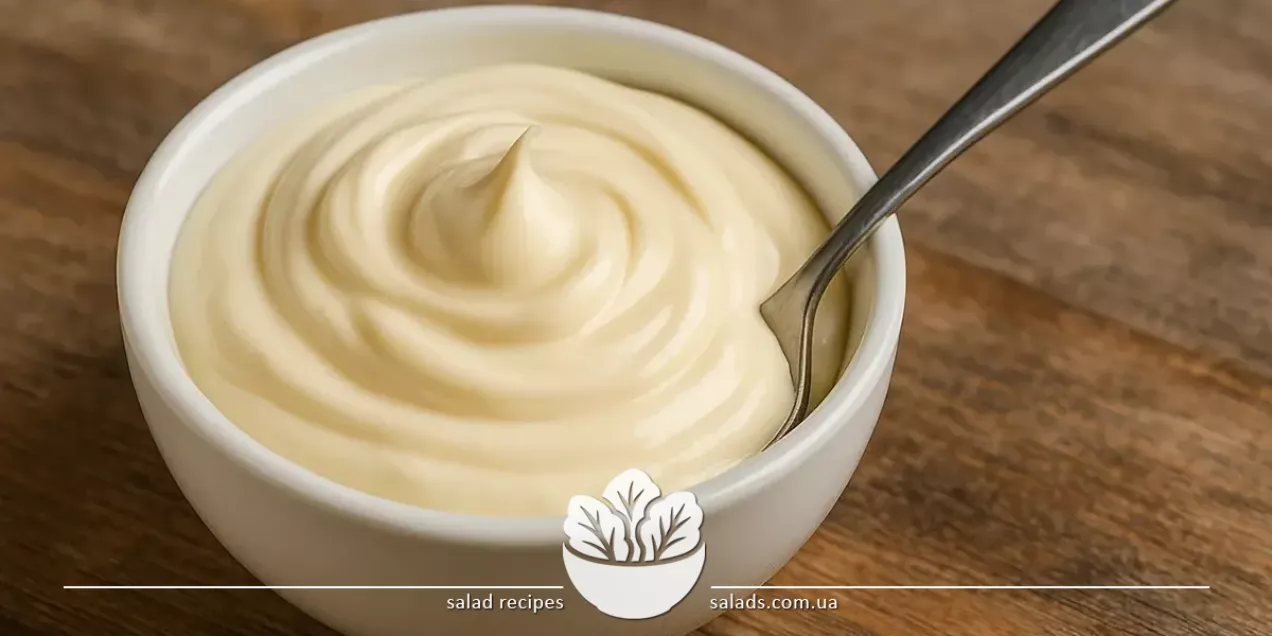
Mayonnaise

Mayonnaise is an emulsion-based sauce whose main components are vegetable oil, egg yolks, mustard, and an acidic element such as lemon juice or vinegar. It has a gentle, mild taste and a thick, creamy consistency. Mayonnaise is widely used as a dressing for salads, an addition to cold and hot dishes, and a base for various sauces. Both industrial and homemade mayonnaise recipes exist, differing in ingredients and preparation methods. More sauces and seasonings can be found in the sauces section.
Salad Recipes with Mayonnaise
Classic Recipes with Mayonnaise
Mayonnaise is an essential sauce in many traditional and modern recipes. It is commonly used as a dressing for salads, such as the popular vegetable salad with white cabbage or a salad with hard cheese and eggs. Mayonnaise adds tenderness, creaminess, and a light tanginess to dishes, resulting in a well-balanced flavor. In appetizers, mayonnaise is often paired with fish, especially lightly salted salmon or seafood like calamari. It is used as a base for various sauces and creams, as well as a filling for sandwiches, roulades, and casseroles. Mayonnaise is also a key ingredient in many traditional dishes that require richness and smoothness. It can be mixed with herbs like aromatic dill, enhancing freshness and making the sauce lighter. Due to its versatility, mayonnaise remains popular in cuisines around the world.
Mayonnaise in World Cuisine
Mayonnaise is one of the most popular sauces in many cuisines worldwide. In European cuisine, it is traditionally used as a salad dressing and an addition to cold appetizers and sandwiches. In French cuisine, mayonnaise serves as a base for classic sauces such as aioli or tartar, which are served with seafood and meat. In American cuisine, mayonnaise is popular in making sandwiches, chicken and vegetable salads, as well as in burgers and grill sauces. In Asia, mayonnaise is often combined with soy-based sauces, chili, and garlic, creating unique blends for noodles, rice, and fried dishes. In many countries, mayonnaise is used to create soft and creamy textures in desserts, salads, and appetizers, making it a truly versatile product. Its balanced flavor and creamy structure contribute to its widespread use in regional cuisines across the globe.
Choosing and Evaluating the Quality of Mayonnaise
When selecting mayonnaise, it is important to pay attention to the product’s ingredients and quality. The best choice is mayonnaise made from natural ingredients – oil, eggs, mustard, lemon juice or vinegar – without artificial colors, flavors, or preservatives. The fewer additives it contains, the more natural and beneficial the product is. In stores, you can find both industrial and homemade mayonnaise. Industrial versions offer stable consistency, longer shelf life, and a variety of flavors. Homemade mayonnaise is prepared from fresh ingredients, offering a more intense flavor and natural texture but with a shorter shelf life. When choosing mayonnaise, check the manufacturing date, expiration date, and storage conditions. The best mayonnaise contains a moderate amount of fat and has a balanced flavor that enhances, rather than overpowers, the dish. Choosing the right mayonnaise is key to successful cooking.
Preparation and Culinary Uses of Mayonnaise
Homemade mayonnaise is made by gradually whipping eggs with vegetable oil while adding mustard, salt, sugar, and an acid such as lemon juice or vinegar. It’s important to follow the proportions and pace of oil addition to avoid separation and achieve a thick, creamy consistency. Garlic, spices, or herbs can be added to enhance the flavor. In cooking, mayonnaise is used as a salad dressing, a base for sauces, spreads, fillings, and marinades. It pairs well with vegetables, meat, fish, eggs, and cheese. Mayonnaise is often added to cold appetizers, sandwiches, roulades, and hot dishes, where it acts as a binding agent and adds softness. Industrial sauces offer a more stable texture and longer shelf life, while homemade ones provide a more distinctive flavor and natural quality. Mayonnaise can serve as a base for various sauces – spicy, sweet, or sweet-and-sour – making it a versatile ingredient in the kitchen.
Storing Mayonnaise and Using Leftovers
Unopened industrial mayonnaise can be stored at room temperature, but once opened, it should be kept in the refrigerator and used within 7-10 days. Homemade mayonnaise, made from fresh ingredients without preservatives, must be stored exclusively in the refrigerator, typically for no longer than 3-4 days. To prevent spoilage, use clean utensils and containers when handling mayonnaise. It is not recommended to reheat the product, as this may cause separation and degrade its taste. Leftover mayonnaise can be used to make sauces, dressings, spreads, or as an addition to dishes. It can also be included in marinades or used as a base for creamy desserts. Using mayonnaise wisely helps preserve its taste and beneficial properties while reducing food waste.










